Abstract
Injury induced in Escherichia coli cells by chlorination was studied from a physiological standpoint. Predictable and reproducible injury was found to occur rapidly in 0.5 mg of chlorine per liter and was reversible under nonselective conditions. There was an extended lag period in the growth of chlorinated cells not seen in control suspensions followed by the resumption of logarithmic growth at a rate equaling that of control cells. The aldolase activity of cells chlorinated in vivo was equivalent to that obtained for control cells. Oxygen uptake experiments showed that chlorinated cells underwent a decrease in respiration that was not immediatedly repaired in the presence of reducing agents. This effect was more pronouned in rich media containing reducing agents. Uptake of metabolities was inhibited by chlorine injury as shown with experiments using 14C-labeled glucose and algal protein hydrolysate.
Full text
PDF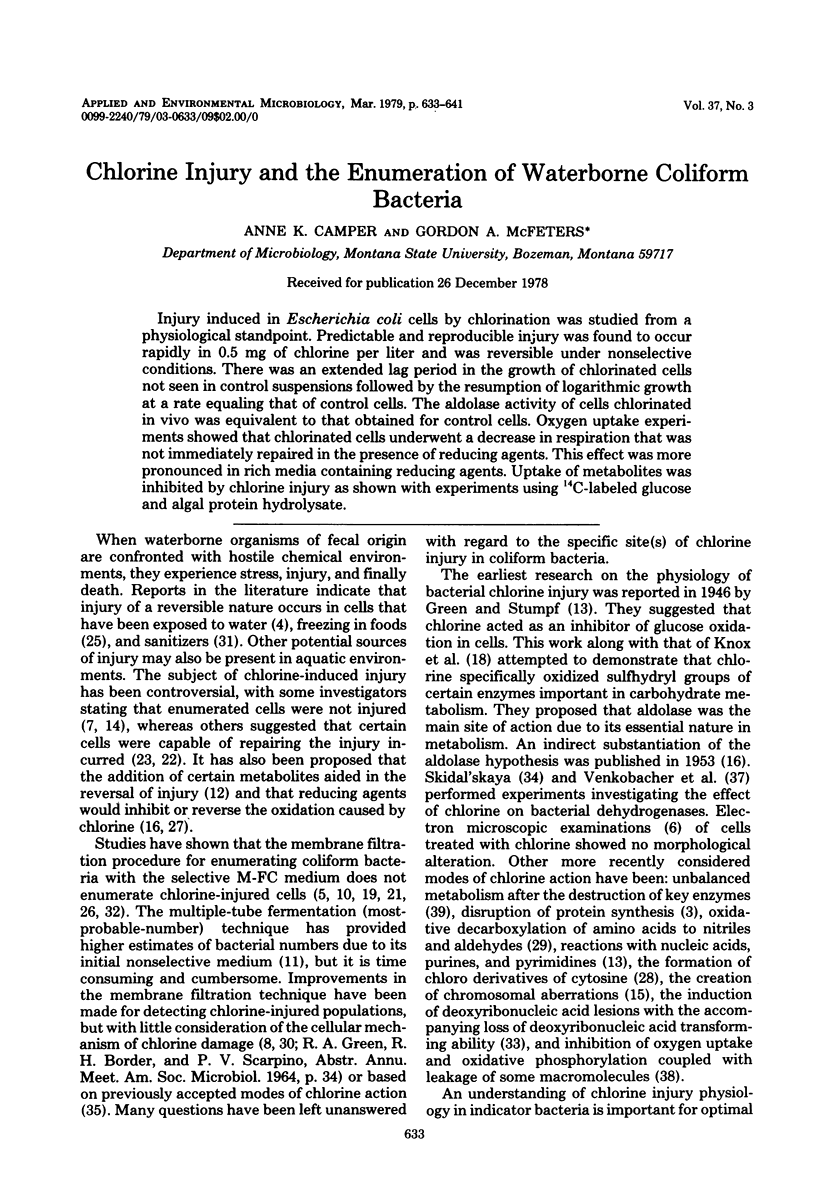


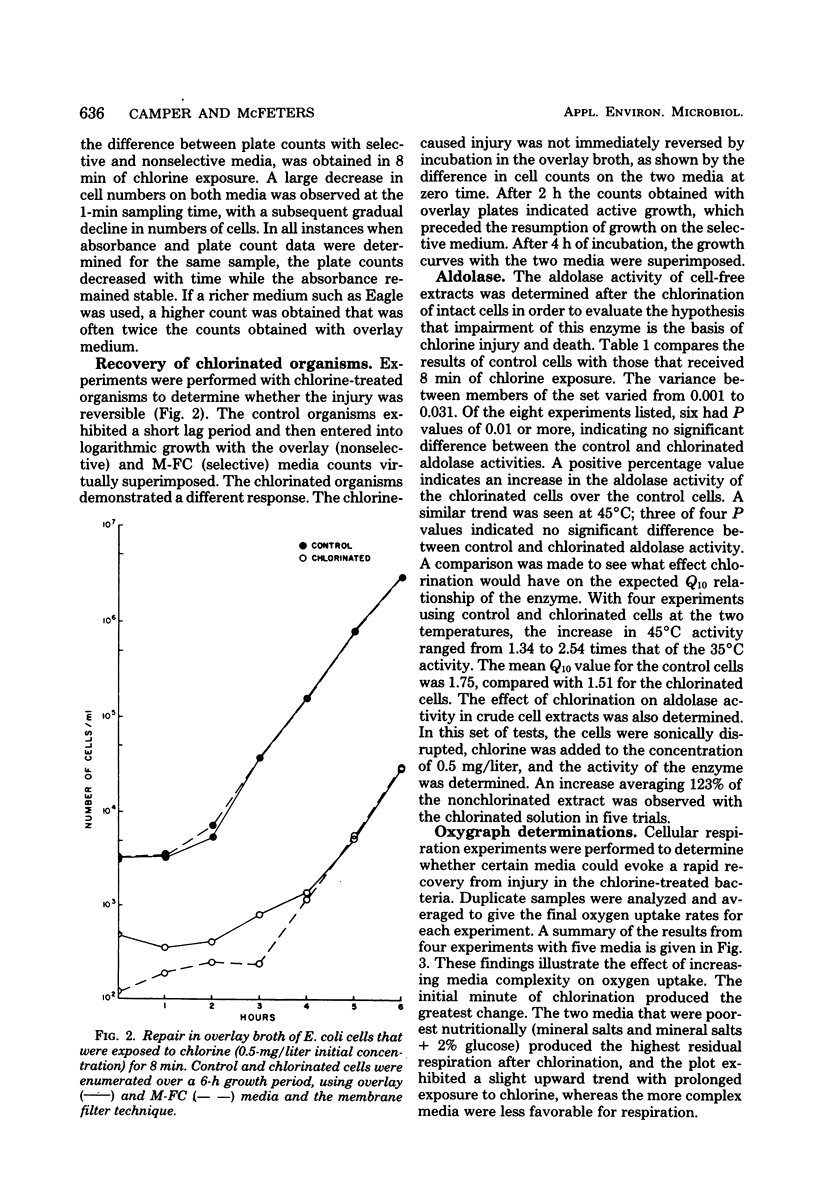

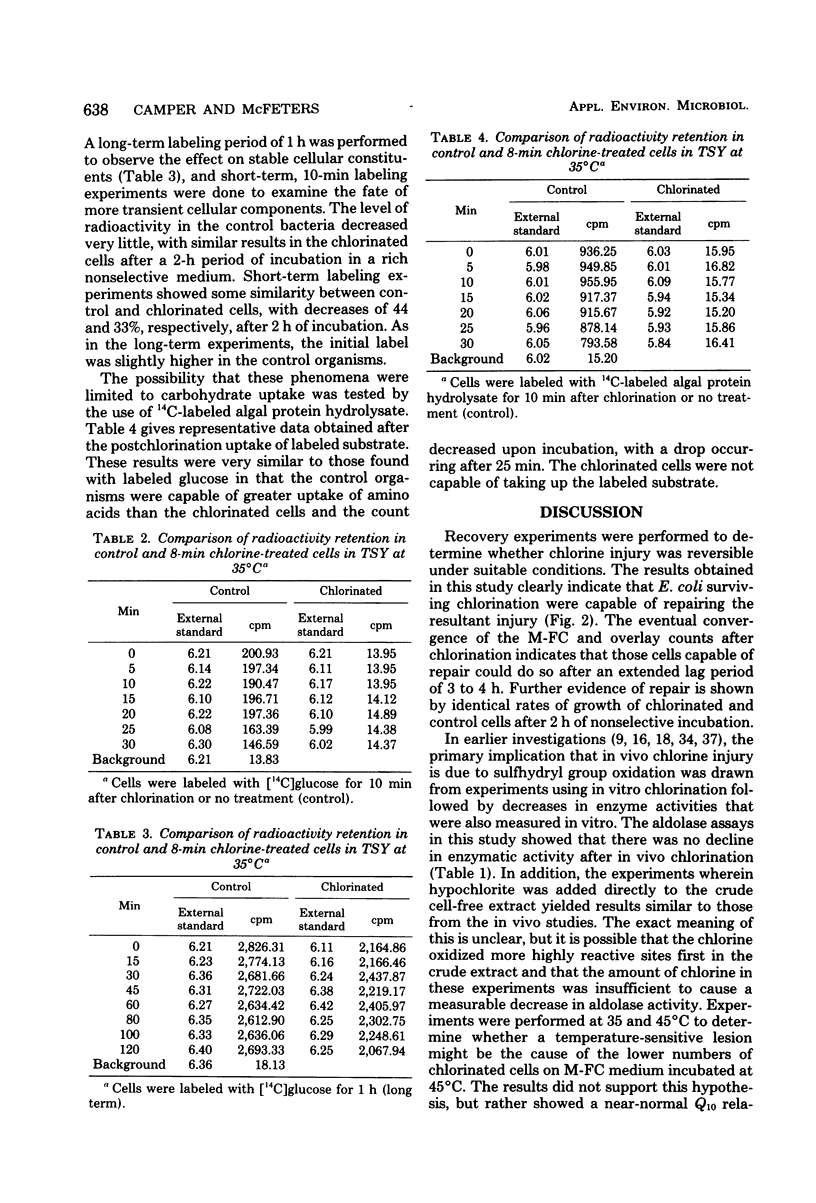
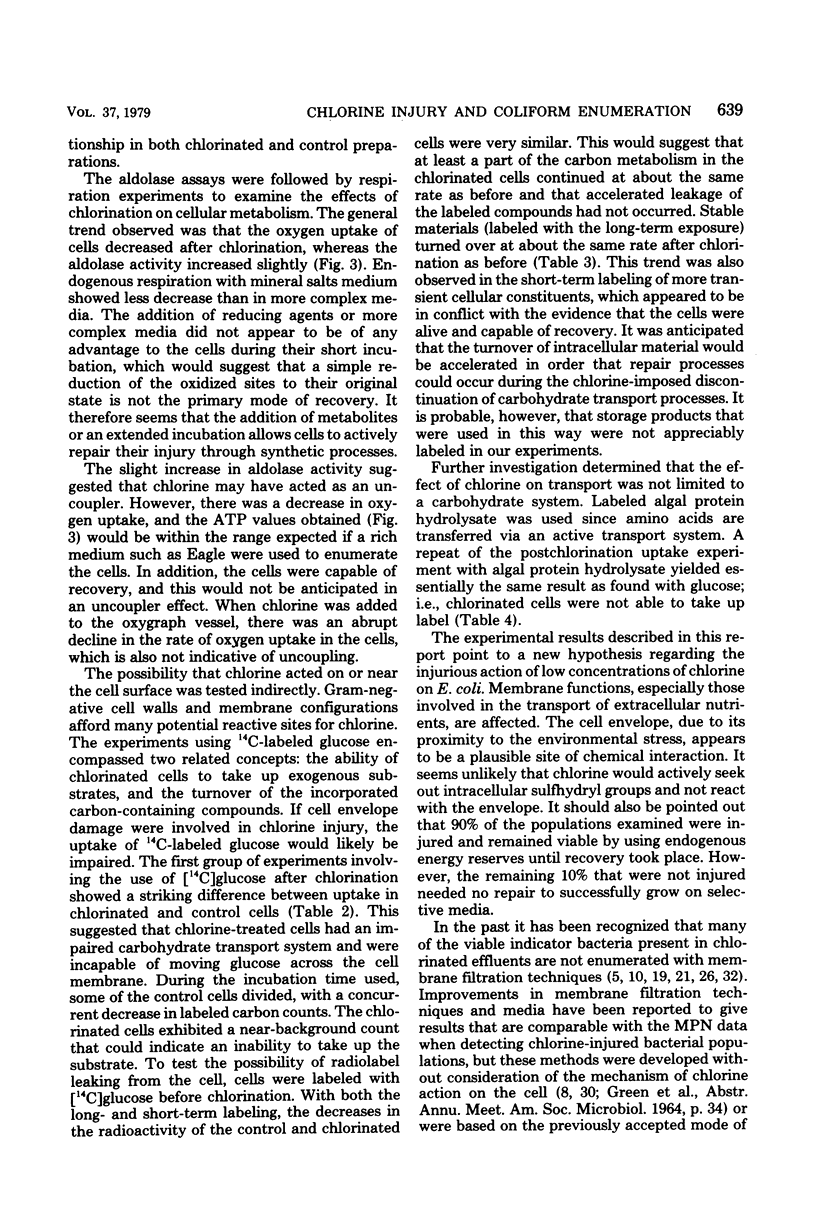
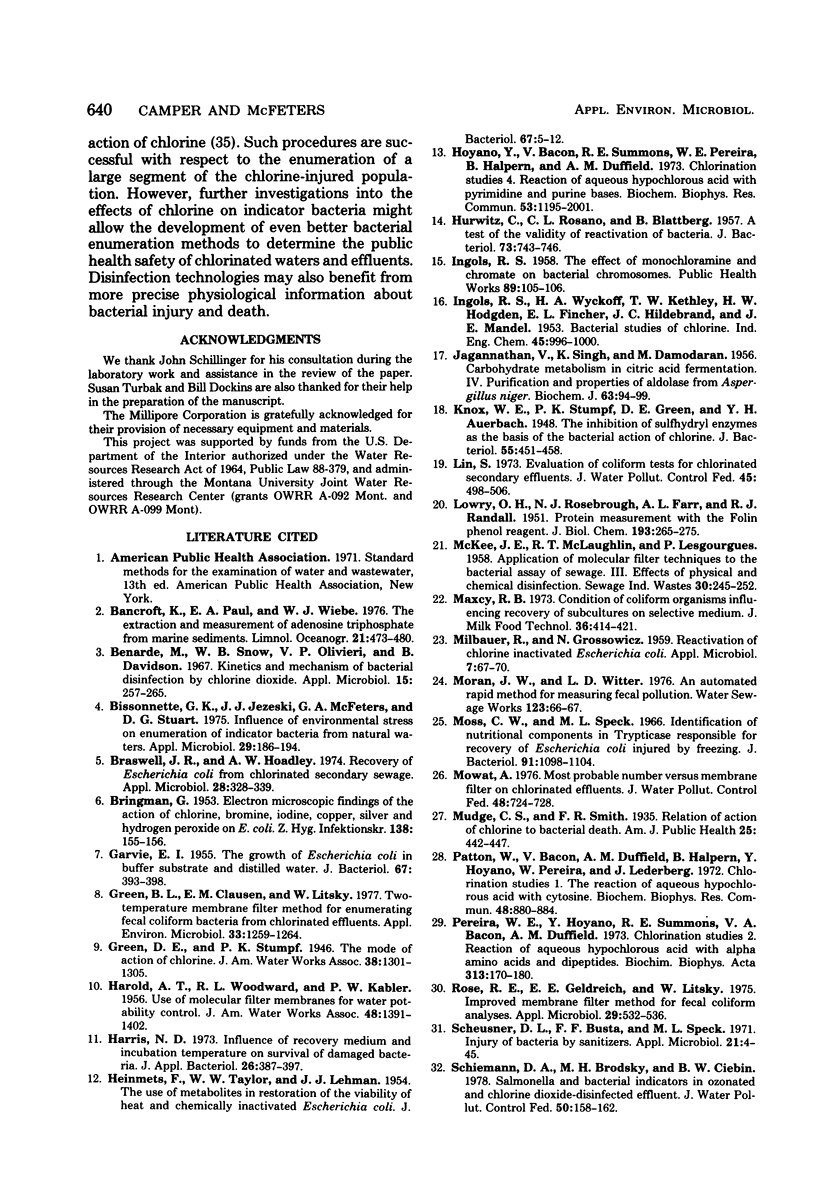
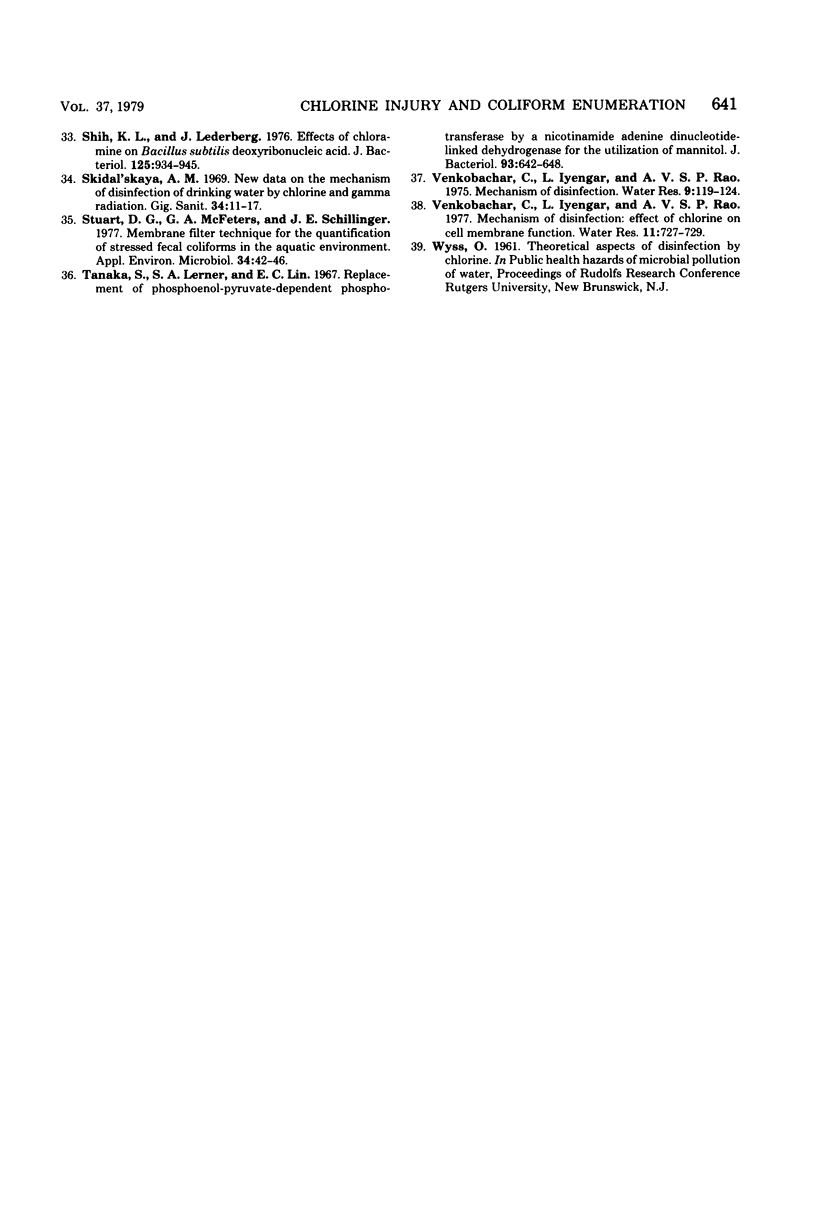
Selected References
These references are in PubMed. This may not be the complete list of references from this article.
- Benarde M. A., Snow W. B., Olivieri V. P., Davidson B. Kinetics and mechanism of bacterial disinfection by chlorine dioxide. Appl Microbiol. 1967 Mar;15(2):257–265. doi: 10.1128/am.15.2.257-265.1967. [DOI] [PMC free article] [PubMed] [Google Scholar]
- Bissonnette G. K., Jezeski J. J., McFeters G. A., Stuart D. G. Influence of environmental stress on enumeration of indicator bacteria from natural waters. Appl Microbiol. 1975 Feb;29(2):186–194. doi: 10.1128/am.29.2.186-194.1975. [DOI] [PMC free article] [PubMed] [Google Scholar]
- Braswell J. R., Hoadley A. W. Recovery of Escherichia coli from chlorinated secondary sewage. Appl Microbiol. 1974 Aug;28(2):328–329. doi: 10.1128/am.28.2.328-329.1974. [DOI] [PMC free article] [PubMed] [Google Scholar]
- GARVIE E. I. The growth of Escherichia coli in buffer substrate and distilled water. J Bacteriol. 1955 Apr;69(4):393–398. doi: 10.1128/jb.69.4.393-398.1955. [DOI] [PMC free article] [PubMed] [Google Scholar]
- Green B. L., Clausen E. M., Litsky W. Two-temperature membrane filter method for enumerating fecal coliform bacteria from chlorinated effluents. Appl Environ Microbiol. 1977 Jun;33(6):1259–1264. doi: 10.1128/aem.33.6.1259-1264.1977. [DOI] [PMC free article] [PubMed] [Google Scholar]
- HEIMETS F., TAYLOR W. W., LEHMAN J. J. The use of metabolites in the restoration of the viability of heat and chemically inactivated Escherichia coli. J Bacteriol. 1954 Jan;67(1):5–12. doi: 10.1128/jb.67.1.5-12.1954. [DOI] [PMC free article] [PubMed] [Google Scholar]
- HURWITZ C., ROSANO C. L., BLATTBERG B. A test of the validity of reactivation of bacteria. J Bacteriol. 1957 Jun;73(6):743–746. doi: 10.1128/jb.73.6.743-746.1957. [DOI] [PMC free article] [PubMed] [Google Scholar]
- Hoyano Y., Bacon V., Summons R. E., Pereira W. E., Halpern B., Duffield A. M. Chlorination studies. IV. The reaction of aqueous hypochlorous acid with pyrimidine and purine bases. Biochem Biophys Res Commun. 1973 Aug 21;53(4):1195–1199. doi: 10.1016/0006-291x(73)90591-3. [DOI] [PubMed] [Google Scholar]
- JAGANNATHAN V., SINGH K., DAMODARAN M. Carbohydrate metabolism in citric acid fermentation. 4. Purification and properties of aldolase from Aspergillus niger. Biochem J. 1956 May;63(1):94–105. doi: 10.1042/bj0630094. [DOI] [PMC free article] [PubMed] [Google Scholar]
- Knox W. E., Stumpf P. K., Green D. E., Auerbach V. H. The Inhibition of Sulfhydryl Enzymes as the Basis of the Bactericidal Action of Chlorine. J Bacteriol. 1948 Apr;55(4):451–458. [PMC free article] [PubMed] [Google Scholar]
- LOWRY O. H., ROSEBROUGH N. J., FARR A. L., RANDALL R. J. Protein measurement with the Folin phenol reagent. J Biol Chem. 1951 Nov;193(1):265–275. [PubMed] [Google Scholar]
- Lin S. Evaluation of coliform tests for chlorinated secondary effluents. J Water Pollut Control Fed. 1973 Mar;45(1):498–506. [PubMed] [Google Scholar]
- Lu Shih K., Lederberg J. Effects of chloramine on Bacillus subtilis deoxyribonucleic acid. J Bacteriol. 1976 Mar;125(3):934–945. doi: 10.1128/jb.125.3.934-945.1976. [DOI] [PMC free article] [PubMed] [Google Scholar]
- MILBAUER R., GROSSOWICZ N. Reactivation of chlorine-inactivated Escherichia coli. Appl Microbiol. 1959 Mar;7(2):67–70. doi: 10.1128/am.7.2.67-70.1959. [DOI] [PMC free article] [PubMed] [Google Scholar]
- Moss C. W., Speck M. L. Identification of nutritional components in trypticase responsible for recovery of Escherichia coli injured by freezing. J Bacteriol. 1966 Mar;91(3):1098–1104. doi: 10.1128/jb.91.3.1098-1104.1966. [DOI] [PMC free article] [PubMed] [Google Scholar]
- Mudge C. S., Smith F. R. Relation of Action of Chlorine to Bacterial Death. Am J Public Health Nations Health. 1935 Apr;25(4):442–447. doi: 10.2105/ajph.25.4.442. [DOI] [PMC free article] [PubMed] [Google Scholar]
- Patton W., Bacon V., Duffield A. M., Halpern B., Hoyano Y., Pereira W., Lederberg J. Chlorination studies. I. The reaction of aqueous hypochlorous acid with cytosine. Biochem Biophys Res Commun. 1972 Aug 21;48(4):880–884. doi: 10.1016/0006-291x(72)90690-0. [DOI] [PubMed] [Google Scholar]
- Pereira W. E., Hoyano Y., Summons R. E., Bacon V. A., Duffield A. M. Chlorination studies. II. The reaction of aqueous hypochlorous acid with alpha-amino acids and dipeptides. Biochim Biophys Acta. 1973 Jun 20;313(1):170–180. doi: 10.1016/0304-4165(73)90198-0. [DOI] [PubMed] [Google Scholar]
- Rose R. E., Geldreich E. E., Litsky W. Improved membrane filter method for fecal coliform analysis. Appl Microbiol. 1975 Apr;29(4):532–536. doi: 10.1128/am.29.4.532-536.1975. [DOI] [PMC free article] [PubMed] [Google Scholar]
- Scheusner D. L., Busta F. F., Speck M. L. Injury of bacteria by sanitizers. Appl Microbiol. 1971 Jan;21(1):41–45. doi: 10.1128/am.21.1.41-45.1971. [DOI] [PMC free article] [PubMed] [Google Scholar]
- Schiemann D. A., Brodsky M. H., Ciebin B. W. Salmonella and bacterial indicators in ozonated and chlorine dioxide-disinfected effluent. J Water Pollut Control Fed. 1978 Jan;50(1):158–162. [PubMed] [Google Scholar]
- Stuart D. G., McFeters G. A., Schillinger J. E. Membrane filter technique for the quantification of stressed fecal coliforms in the aquatic environment. Appl Environ Microbiol. 1977 Jul;34(1):42–46. doi: 10.1128/aem.34.1.42-46.1977. [DOI] [PMC free article] [PubMed] [Google Scholar]
- Tanaka S., Lerner S. A., Lin E. C. Replacement of a phosphoenolpyruvate-dependent phosphotransferase by a nicotinamide adenine dinucleotide-linked dehydrogenase for the utilization of mannitol. J Bacteriol. 1967 Feb;93(2):642–648. doi: 10.1128/jb.93.2.642-648.1967. [DOI] [PMC free article] [PubMed] [Google Scholar]


